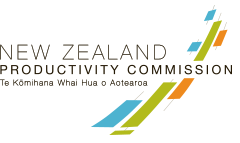Reporting on our outcomes
Lifting productivity of New Zealand and lifting the wellbeing of New Zealanders
|
Outcome |
Measure |
Assessment method |
Location of reporting |
|---|---|---|---|
|
Lifting the wellbeing of New Zealand; and lift New Zealand’s productivity |
Volume and quality of formal and informal research output (e.g. inquiry reports, research working paper series, and broader commentary on trends in New Zealand productivity and wellbeing such as our regular Productivity by the numbers report) |
A summary of performance evaluation material relevant to the year under review (e.g. expert reviews, surveys, and focus group reports of formal and informal outputs). |
See pages 18–45 |
|
Monitoring and review of Government responses to inquiries and Cabinet minutes and ongoing follow-up with implementation agencies. |
See page 14 |
||
| Monitoring of media (including social media) commentary on formal and informal outputs. | See pages 16 and 22 | ||
| Monitoring of Hansard, Select Committee reports and citation tools on formal and informal outputs. | See pages 16 and 22 |
Publishing research
Our research team has been focused on primary research to support our understanding of the inquiry topics. This has included work on how migrants contribute to productivity in New Zealand, migrant labour market pathways and outcomes, and income mobility patterns in New Zealand. The results from these research projects have fed into the work of our Immigration and A Fair Chance for All inquiries. The results were presented at the New Zealand Association of Economists annual conference, as well as several other public seminars and lectures. At the end of this reporting period, they were being prepared for publication as working papers and in peer-reviewed journals.
Penny Mok and Gail Pacheco’s paper Income Protection in the New Zealand Tax-transfer System was published in the peer-reviewed journal New Zealand Economic Papers.
Income Mobility in New Zealand 2007–2020: Combining Household Survey and Census Data, by John Creedy and Quy Ta was featured in the Working Papers in Public Finance series by Victoria University of Wellington in May 2022.
Immigration by the numbers is a comprehensive collection of the immigration trends and quantitative analysis that informed the Commission’s inquiry into immigration settings for New Zealand’s long- term prosperity and wellbeing. The style of the report was built on last year’s successful Productivity by the numbers publication.
We restarted the Productivity Hub1, in collaboration with the Government Economics Network. This includes a Research Leaders Group2, to bring together research leaders from across the government sector. This group includes representatives from Treasury, the Ministry of Business, Innovation and Employment, the Ministry of Foreign Affairs and Trade, New Zealand Infrastructure Commission, Te Puni Kōkiri, the Social Wellbeing Agency, Statistics New Zealand, the Ministry of Transport, and the Reserve Bank of New Zealand.
Undertaking inquiries
Two new inquiries were assigned by the Minister of Finance shortly after the completion of our Frontier Firms inquiry in April 2021.
Immigration: Fit for the future
The Commission received the terms of reference (ToR) from the Minister of Finance for the Immigration inquiry on 12 April 2021. The ToR alongside the inquiry’s call for submissions and issues paper (released in June 2021) set the scene for this work programme from July 2021 to June 2022.
A Fair Chance For All: Breaking the cycle of persistent disadvantage
In June 2021, the Government asked the Commission to scope a new inquiry into the drivers of persistent disadvantage within people’s lifetimes and across generations. As part of scoping, the Government asked us to consult the public on what the terms of reference should cover – a new approach for the Commission. To assist with this, a scoping paper was published on 21 July, with submissions and feedback due by 27 August 2021.
From January through to June 2022 we undertook work to inform the development of our interim report. This included commissioning and/or releasing the following pieces of research:
- Together alone – a review of joined up social services (by consulting economist Julie Fry).
- Te puna kōrero: Understanding persistent disadvantage in Aotearoa New Zealand – a thematic review of existing research into the lived experiences of people living in persistent disadvantage.
- A report on colonisation, racism, and wellbeing, prepared by Haemata
- Analysis of family resources across the early life course and children’s development in Aotearoa New Zealand, using the Growing Up in New Zealand study data set, undertaken by Dr. Kate C. Prickett, Dr. Sarah-Jane Paine, Associate Professor Polly Atatoa Carr Te Ngira and Professor Susan Morton.
We also undertook our own quantitative analysis into persistent disadvantage, linking the Census and the Household Economic Survey, and collaborating with Dr John Creedy at Victoria University of Wellington to examine income mobility patterns in New Zealand over the short to medium term.
The inquiry’s interim and final reports are due to be published in 2022 and 2023 respectively.


